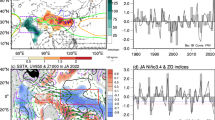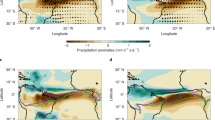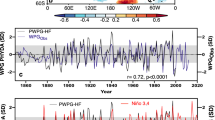Abstract
The northeastern United States (NEUS) and the adjacent Northwest Atlantic Shelf (NWS) have emerged as warming hotspots, but the connection between them remains unexplored. Here we use gridded observational and reanalysis datasets to show that the twentieth-century surface air temperature increase along the coastal NEUS is exceptional on the continental and hemispheric scale and is induced by a combination of two factors: the sea surface temperature (SST) increase in the NWS associated with a weakening Atlantic Meridional Overturning Circulation (AMOC), and atmospheric circulation changes associated with a more persistent positive North Atlantic Oscillation. These connections are important because AMOC slowdown and NWS warming are projected to continue. A survey of climate model simulations indicates that realistic SST representation at high spatial resolution might be a minimum requirement to capture the observed pattern of coastal warming, suggesting that prior projection-based assessments may not have captured key features in this populous region.
This is a preview of subscription content, access via your institution
Access options
Access Nature and 54 other Nature Portfolio journals
Get Nature+, our best-value online-access subscription
$29.99 / 30 days
cancel any time
Subscribe to this journal
Receive 12 print issues and online access
$209.00 per year
only $17.42 per issue
Buy this article
- Purchase on Springer Link
- Instant access to full article PDF
Prices may be subject to local taxes which are calculated during checkout





Similar content being viewed by others
Data availability
All underlying raw observational and model data are publically available online. For temperature data, see https://crudata.uea.ac.uk/cru/data/hrg/ for CRU TS v4 data; http://berkeleyearth.org/data/ for Berkeley Earth data; https://www.ncei.noaa.gov/access/metadata/landing-page/bin/iso?id=gov.noaa.ncdc:C00332 for nClimGrid; and https://psl.noaa.gov/data/gridded/data.20thC_ReanV3.html for 20CRv3 data. For SST data, see https://www.metoffice.gov.uk/hadobs/hadisst/ for HadISST; and https://www.ncdc.noaa.gov/data-access/marineocean-data/extended-reconstructed-sea-surface-temperature-ersst-v5 for ERSST V5.
CMIP6 model output is available from the Earth System Grid Federation (ESGF; https://esgf-node.llnl.gov/projects/cmip6). CESM-LENS data are available from the UCAR website (https://www.cesm.ucar.edu/projects/community-projects/LENS/data-sets.html). The AMOC index time series are available at http://www.pik-potsdam.de/~caesar/AMOC_slowdown/ and http://www.pik-potsdam.de/~stefan/amoc_index_data.html.
Code availability
The code used in the analyses described in this study is available in a GitHub repository: https://github.com/avkarmalkar/KH2021_NCC. More information about the code can be obtained from the corresponding author upon reasonable request.
References
Mascioli, N. R., Previdi, M., Fiore, A. M. & Ting, M. Timing and seasonality of the United States ‘warming hole’. Environ. Res. Lett. 12, 034008 (2017).
Vose, R., Easterling, D. R., Kunkel, K. & Wehner, M. in Climate Science Special Report: A Sustained Assessment Activity of the U.S. Global Change Research Program (eds Wuebbles, D. J. et al.) 267–300 (U.S. Global Change Research Program, 2017).
Mooney, C., Muyskens, J. & Van Houten, C. Dangerous new hot zones are spreading around the world. The Washington Post (13 August 2019).
Karmalkar, A. V. & Bradley, R. S. Consequences of global warming of 1.5 °C and 2 °C for regional temperature and precipitation changes in the contiguous United States. PLoS ONE 12, e0168697 (2017).
Horton, R. et al. in Climate Change Impacts in the United States: The Third National Climate Assessment (eds Melillo, J. M. et al.) 371–395 (US Global Change Research Program, 2014).
Mills, K. E. et al. Fisheries management in a changing climate: lessons from the 2012 ocean heat wave in the Northwest Atlantic. Oceanography 26, 191–195 (2013).
Pershing, A. J. et al. Slow adaptation in the face of rapid warming leads to collapse of the Gulf of Maine cod fishery. Science 350, 809–812 (2015).
Chen, Z. et al. Long‐term SST variability on the Northwest Atlantic continental shelf and slope. Geophys. Res. Lett. 47, e2019GL085455 (2020).
Saba, V. S. et al. Enhanced warming of the Northwest Atlantic Ocean under climate change. J. Geophys. Res. Oceans 121, 118–132 (2016).
Alexander, M. A., Shin, S. I., Scott, J. D., Curchitser, E. & Stock, C. The response of the Northwest Atlantic Ocean to climate change. J. Clim. 33, 405–428 (2020).
Zielinski, G. A. & Keim, B. D. New England Weather, New England Climate (UPNE, 2005).
Hurrell, J. W. & Deser, C. North Atlantic climate variability: the role of the North Atlantic Oscillation. J. Mar. Syst. 79, 231–244 (2010).
Battisti, D. S., Vimont, D. J. & Kirtman, B. P. 100 years of progress in understanding the dynamics of coupled atmosphere-ocean variability. Meteorol. Monogr. 59, 8.1–8.57 (2019).
Ortega, P. et al. A model-tested North Atlantic Oscillation reconstruction for the past millennium. Nature 523, 71–74 (2015).
Zhang, R. et al. A review of the role of the Atlantic Meridional Overturning Circulation in Atlantic multidecadal variability and associated climate impacts. Rev. Geophys. 57, 316–375 (2019).
Delworth, T. L. & Mann, M. E. Observed and simulated multidecadal variability in the Northern Hemisphere. Clim. Dyn. 16, 661–676 (2000).
Delworth, T. L. et al. The central role of ocean dynamics in connecting the North Atlantic Oscillation to the extratropical component of the Atlantic multidecadal oscillation. J. Clim. 30, 3789–3805 (2017).
Sutton, R. T. & Hodson, D. L. Atlantic Ocean forcing of North American and European summer climate. Science 309, 115–118 (2005).
Chen, K., Gawarkiewicz, G. G., Lentz, S. J. & Bane, J. M. Diagnosing the warming of the Northeastern US Coastal Ocean in 2012: a linkage between the atmospheric jet stream variability and ocean response. J. Geophys. Res. Oceans 119, 218–227 (2014).
Chen, K. & Kwon, Y. O. Does Pacific variability influence the Northwest Atlantic Shelf temperature? J. Geophys. Res. Oceans 123, 4110–4131 (2018).
Shearman, R. K. & Lentz, S. J. Long-term sea surface temperature variability along the US East Coast. J. Phys. Oceanogr. 40, 1004–1017 (2010).
Caesar, L., Rahmstorf, S., Robinson, A., Feulner, G. & Saba, V. Observed fingerprint of a weakening Atlantic Ocean overturning circulation. Nature 556, 191–196 (2018).
Rahmstorf, S. et al. Exceptional twentieth-century slowdown in Atlantic Ocean overturning circulation. Nat. Clim. Change 5, 475–480 (2015).
Dima, M. & Lohmann, G. Evidence for two distinct modes of large-scale ocean circulation changes over the last century. J. Clim. 23, 5–16 (2010).
Wu, L. et al. Enhanced warming over the global subtropical western boundary currents. Nat. Clim. Change 2, 161–166 (2012).
Yang, H. et al. Poleward shift of the major ocean gyres detected in a warming climate. Geophys. Res. Lett. 47, e2019GL085868 (2020).
Neto, A. G., Langan, J. A., & Palter, J. B. Changes in the Gulf Stream preceded rapid warming of the Northwest Atlantic Shelf. Commun. Earth Environ. 2, 74 (2021).
Yang, H. et al. Intensification and poleward shift of subtropical western boundary currents in a warming climate. J. Geophys. Res. Oceans 121, 4928–4945 (2016).
Yin, J. H. A consistent poleward shift of the storm tracks in simulations of 21st century climate. Geophys. Res. Lett. 32, L18701 (2005).
Tamarin-Brodsky, T. & Kaspi, Y. Enhanced poleward propagation of storms under climate change. Nat. Geosci. 10, 908–913 (2017).
Minobe, S., Kuwano-Yoshida, A., Komori, N., Xie, S. P. & Small, R. J. Influence of the Gulf Stream on the troposphere. Nature 452, 206–209 (2008).
Yin, J. & Goddard, P. B. Oceanic control of sea level rise patterns along the East Coast of the United States. Geophys. Res. Lett. 40, 5514–5520 (2013).
Gulev, S. K., Latif, M., Keenlyside, N., Park, W. & Koltermann, K. P. North Atlantic Ocean control on surface heat flux on multidecadal timescales. Nature 499, 464–467 (2013).
Deser, C., Alexander, M. A., Xie, S. P. & Phillips, A. S. Sea surface temperature variability: patterns and mechanisms. Annu. Rev. Mar. Sci. 2, 115–143 (2010).
Bradbury, J. A., Keim, B. D. & Wake, C. P. US East Coast trough indices at 500 hPa and New England winter climate variability. J. Clim. 15, 3509–3517 (2002).
Woollings, T. et al. Contrasting interannual and multidecadal NAO variability. Clim. Dyn. 45, 539–556 (2015).
Liu, W., Fedorov, A. V., Xie, S. P. & Hu, S. Climate impacts of a weakened Atlantic Meridional Overturning Circulation in a warming climate. Sci. Adv. 6, eaaz4876 (2020).
Karnauskas, K. B., Zhang, L. & Amaya, D. J. The atmospheric response to North Atlantic SST trends, 1870–2019. Geophys. Res. Lett. 48, e2020GL090677 (2020).
Gastineau, G. & Frankignoul, C. Influence of the North Atlantic SST variability on the atmospheric circulation during the twentieth century. J. Clim. 28, 1396–1416 (2015).
Deser, C., Knutti, R., Solomon, S. & Phillips, A. S. Communication of the role of natural variability in future North American climate. Nat. Clim. Change 2, 775–779 (2012).
Weijer, W., Cheng, W., Garuba, O. A., Hu, A. & Nadiga, B. T. CMIP6 models predict significant 21st century decline of the Atlantic Meridional Overturning Circulation. Geophys. Res. Lett. 47, e2019GL086075 (2020).
Wang, X., Li, J., Sun, C. & Liu, T. NAO and its relationship with the Northern Hemisphere mean surface temperature in CMIP5 simulations. J. Geophys. Res. Atmos. 122, 4202–4227 (2017).
Kim, W. M., Yeager, S., Chang, P. & Danabasoglu, G. Low-frequency North Atlantic climate variability in the Community Earth System Model large ensemble. J. Clim. 31, 787–813 (2018).
Folland, C. K. et al. The summer North Atlantic Oscillation: past, present, and future. J. Clim. 22, 1082–1103 (2009).
Mueller, N. D. et al. Cooling of US Midwest summer temperature extremes from cropland intensification. Nat. Clim. Change 6, 317–322 (2016).
Roberts, C. D., Jackson, L. & McNeall, D. Is the 2004–2012 reduction of the Atlantic Meridional Overturning Circulation significant? Geophys. Res. Lett. 41, 3204–3210 (2014).
Jackson, L. C., Peterson, K. A., Roberts, C. D. & Wood, R. A. Recent slowing of Atlantic overturning circulation as a recovery from earlier strengthening. Nat. Geosci. 9, 518–522 (2016).
Caesar, L., McCarthy, G. D., Thornalley, G. J. R., Cahill, N. & Rahmstorf, S. Current Atlantic Meridional Overturning Circulation weakest in last millennium. Nat. Geosci. 14, 118–120 (2021).
Roberts, M. J. et al. Sensitivity of the Atlantic Meridional Overturning Circulation to model resolution in CMIP6 HighResMIP simulations and implications for future changes. J. Adv. Model. Earth Syst. 12, e2019MS002014 (2020).
Barnes, E. A. & Screen, J. A. The impact of Arctic warming on the midlatitude jet‐stream: Can it? Has it? Will it? Wiley Interdiscip. Rev. Clim. Change 6, 277–286 (2015).
Vose, R. et al. NOAA Monthly U.S. Climate Gridded Dataset (NClimGrid), Version 1 (NOAA National Centers for Environmental Information, 2014).
Harris, I., Osborn, T. J., Jones, P. & Lister, D. Version 4 of the CRU TS monthly high-resolution gridded multivariate climate dataset. Sci. Data 7, 109 (2020).
Rohde, R. A. & Hausfather, Z. The Berkeley Earth land/ocean temperature record. Earth Syst. Sci. Data 12, 3469–3479 (2020).
Slivinski, L. C. et al. Towards a more reliable historical reanalysis: improvements for version 3 of the Twentieth Century Reanalysis system. Q. J. R. Meteorol. Soc. 145, 2876–2908 (2019).
Compo, G. P. et al. The Twentieth Century Reanalysis Project. Q. J. R. Meteorol. Soc. 137, 1–28 (2011).
Rayner, N. A. A. et al. Global analyses of sea surface temperature, sea ice, and night marine air temperature since the late nineteenth century. J. Geophys. Res. Atmos. 108, 4407 (2003).
Huang, B. et al. Extended reconstructed sea surface temperature, version 5 (ERSSTv5): upgrades, validations, and intercomparisons. J. Clim. 30, 8179–8205 (2017).
Slivinski, L. C. et al. An evaluation of the performance of the Twentieth Century Reanalysis Version 3. J. Clim. 34, 1417–1438 (2021).
Hussain, M. M. & Mahmud, I. pyMannKendall: a python package for non-parametric Mann Kendall family of trend tests. J. Open Source Softw. 4, 1556 (2019).
Dawson, A. eofs: a library for EOF analysis of meteorological, oceanographic, and climate data. J. Open Res. Softw. 4, p.e14 (2016).
Frankignoul, C., Gastineau, G. & Kwon, Y. O. The influence of the AMOC variability on the atmosphere in CCSM3. J. Clim. 26, 9774–9790 (2013).
Eyring, V. et al. Overview of the Coupled Model Intercomparison Project Phase 6 (CMIP6) experimental design and organization. Geosci. Model Dev. 9, 1937–1958 (2016).
Haarsma, R. J. et al. High resolution model intercomparison project (HighResMIP v1. 0) for CMIP6. Geosci. Model Dev. 9, 4185–4208 (2016).
Kay, J. et al. The Community Earth System Model (CESM) large ensemble project: a community resource for studying climate change in the presence of internal climate variability. Bull. Am. Meteorol. Soc. 96, 1333–1349 (2015).
Acknowledgements
We thank the World Climate Research Programme’s Working Group on Coupled Modelling, which is responsible for CMIP, and the climate modelling groups for producing and making available their model output. A.V.K. was supported by Cooperative Agreement No. G19AC00091 from the United States Geological Survey (USGS). The contents of this publication are solely the responsibility of the authors and do not necessarily represent the views of the Northeast Climate Adaptation Science Center or the USGS. This manuscript was submitted for publication with the understanding that the United States Government is authorized to reproduce and distribute reprints for governmental purposes. The funders had no role in study design, data collection and analysis, decision to publish or preparation of the manuscript. R.M.H. received no specific funding for this work.
Author information
Authors and Affiliations
Contributions
A.V.K. designed the study and conducted the analyses. R.M.H. helped with interpretation. A.V.K. led the writing of the manuscript, with R.M.H. providing extensive comments and feedback throughout the process.
Corresponding author
Ethics declarations
Competing interests
The authors declare no competing interests.
Additional information
Peer review information Nature Climate Change thanks Vincent Saba, Sang-Ik Shin and the other, anonymous, reviewer(s) for their contribution to the peer review of this work.
Publisher’s note Springer Nature remains neutral with regard to jurisdictional claims in published maps and institutional affiliations.
Extended data
Extended Data Fig. 1 Spatial patterns of linear surface air temperature trends.
Trends are calculated for CRU dataset over the period 1902-2018 for a, annual (ANN), b, summer (JJA), and c, winter (DJF) mean SAT and are shown as the total change in °C. Yellow color indicates regions with warming over 2 °C between 1902-2018. The insets show trends for the northeastern United States.
Extended Data Fig. 2 Tropospheric temperature trends.
Linear trends in free air temperature anomalies from the 20CRv3 dataset averaged over two cross sections. The trends are presented as the total change in °C over the period 1902-2015. The triangles indicate latitudes and longitudes of Boston and New York City.
Supplementary information
Supplementary Information
Supplementary Figs. 1–11 and Table 1.
Rights and permissions
About this article
Cite this article
Karmalkar, A.V., Horton, R.M. Drivers of exceptional coastal warming in the northeastern United States. Nat. Clim. Chang. 11, 854–860 (2021). https://doi.org/10.1038/s41558-021-01159-7
Received:
Accepted:
Published:
Issue Date:
DOI: https://doi.org/10.1038/s41558-021-01159-7
This article is cited by
-
Rapid 20th century warming reverses 900-year cooling in the Gulf of Maine
Communications Earth & Environment (2022)
-
Optimal selection of representative climate models and statistical downscaling for climate change impact studies: a case study of Rhode Island, USA
Theoretical and Applied Climatology (2022)



